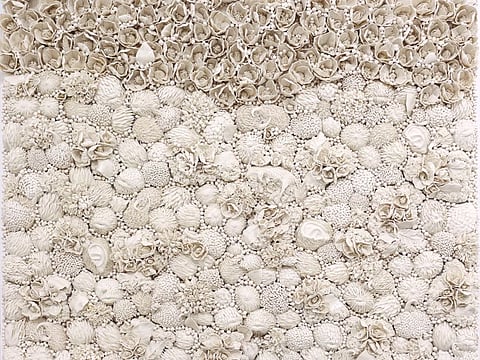Art and Culture: Turkish artist Melis Buyruk's imagined habitats
Melis Buyruk uses ceramic art to create lush, imaginary habitats

Her country has a long history of ceramic art, but Turkish artist Melis Buyruk has developed her own unique way of using this medium. She creates intricate ceramic sculptures inspired by flora and fauna and puts them together to create imaginary habitats.
In her first exhibition in the region at Leila Heller Gallery Dubai titled, Habitat she is showcasing nine large scale works made up of delicate porcelain flowers, animals and other natural elements assembled in wooden boxes.
At a time when the COVID-19 pandemic has forced us to re-examine our relationship with nature, Buyruk’s imagined habitats reflect the beauty and fragility of nature and invite us to contemplate a world where all living creatures can live in harmony.
The artist, who studied ceramics at Selcuk University, makes every piece in her complex habitats by hand spending months on each work. Her porcelain sculptures are detailed and realistic except for the colours, which are white or black with a little touch of gold.
A closer look reveals that the intricate sculptures are hybrids of different elements such as flowers, birds and animals and some have human noses, ears or lips. And concealed within these hybrid flowers are animals like rats, pigs, hawks, dragons, snakes and tarantulas. Elements suggesting the idea of motherhood and nurturing are also part of these surreal habitats.
“I have tried to depict a Utopian world where all living beings are intertwined, nurturing each other and living together in harmony. There is no hierarchy in these habitats and my key message is the equality and inter-dependence of all creatures. I placed unpleasant animals like rats and tarantulas amid the flowers to show that every element of nature is beautiful and has an important role to play in maintaining balance in our environment,” Buyruk says.
Another solo exhibition at the gallery, Material Anatomy by Italian artist Francesca Pasquali is also inspired by nature and encourages us to think about our relationship with it. Pasquali has used plastic materials such as straws and neoprene to create brightly coloured wall reliefs and site-specific installations inspired by coral formations, microscopic anatomies and the layered Italian pastry called Frappa.
Pasquali’s upcycling of mundane throwaway items into valuable artworks references the Italian Arte Povera movement. The single use plastic objects in her installations that she often collects from landfills comment on the consumerism in our society that has led to the pervasive presence of plastic on our planet making her work especially relevant in a region that is linked to petrochemicals.
Visit Habitat and Material Anatomy running at Leila Heller Gallery Dubai for an online 3D tour at www.alserkal.online.
Sign up for the Daily Briefing
Get the latest news and updates straight to your inbox



